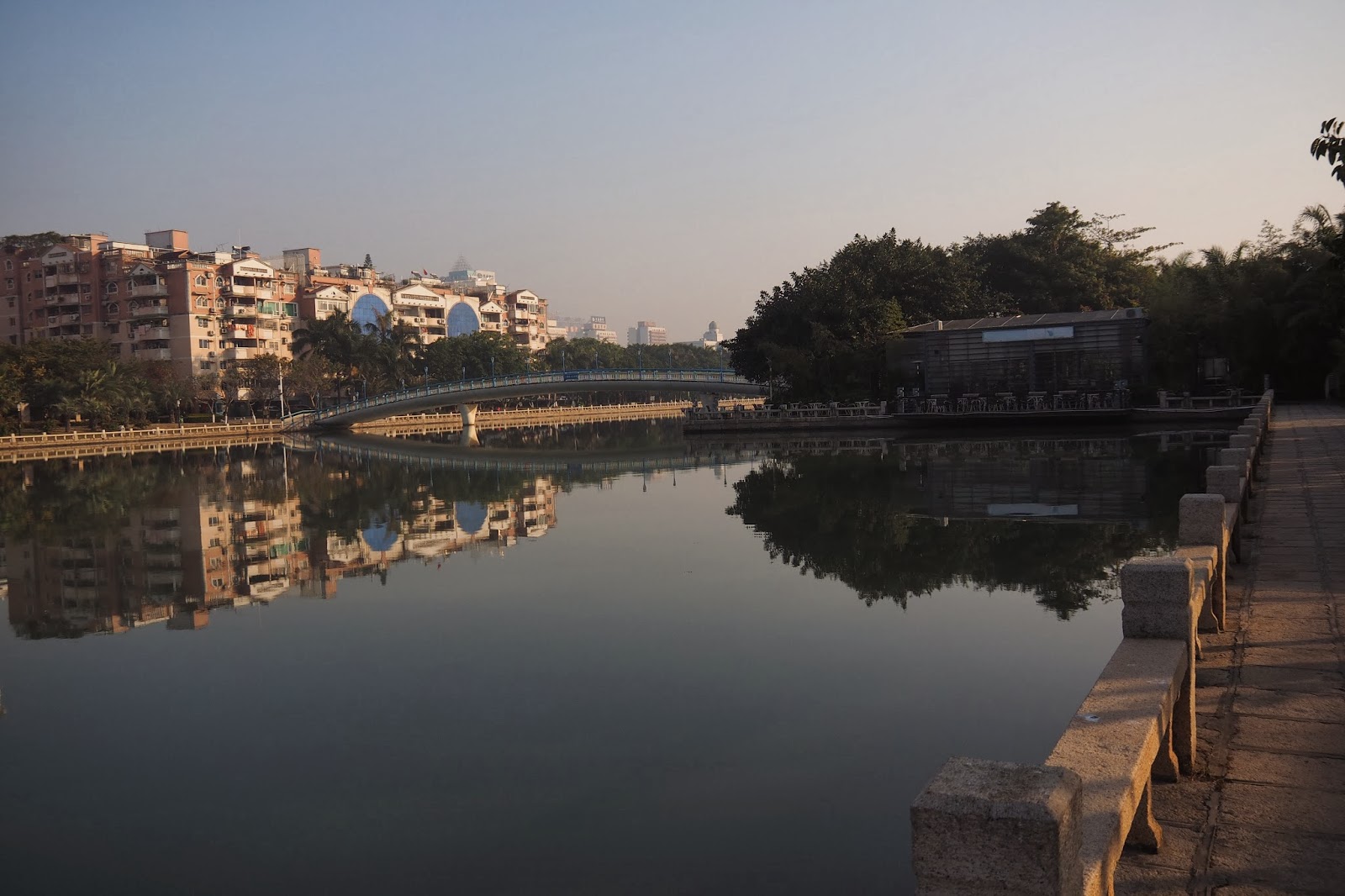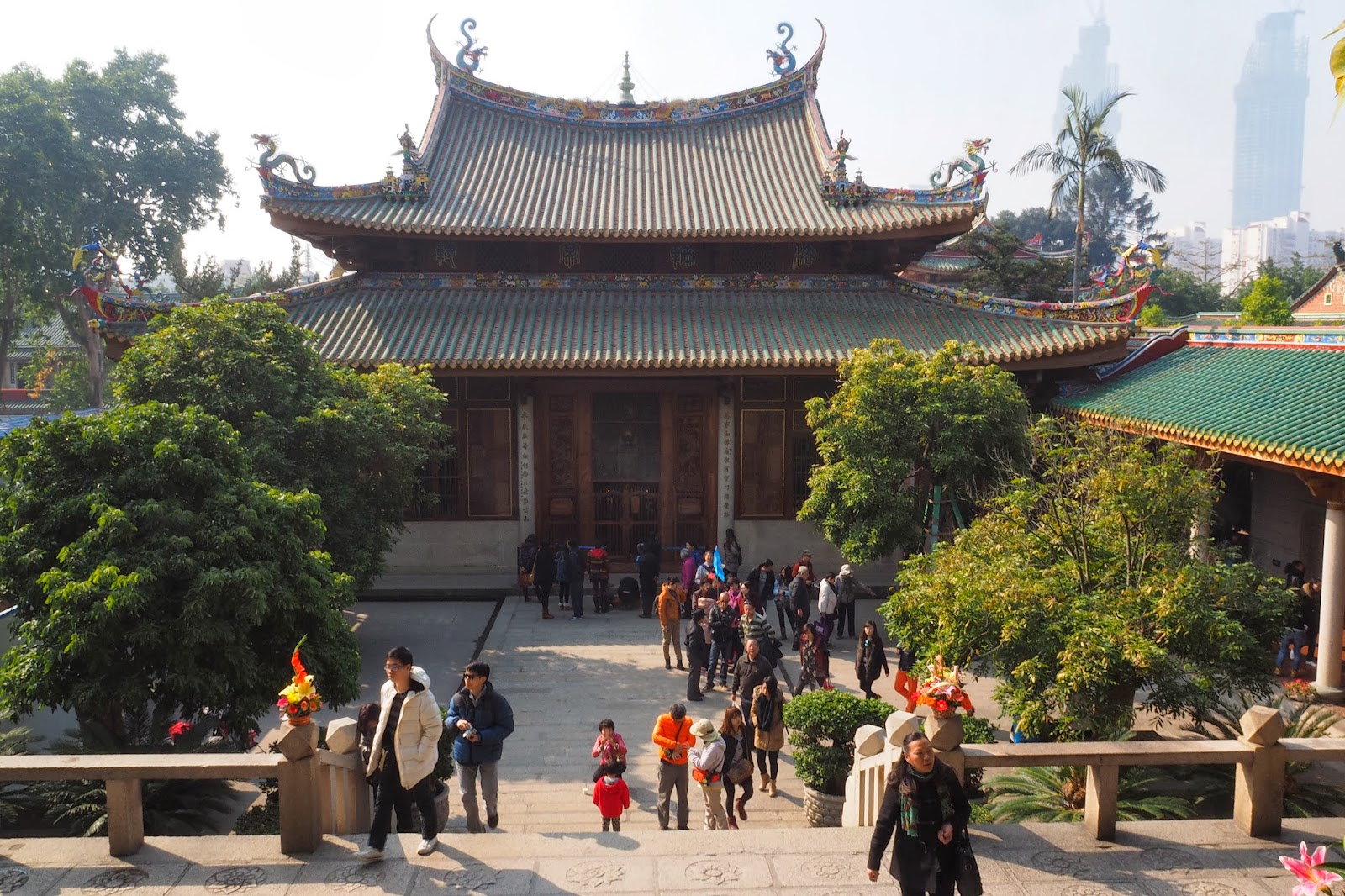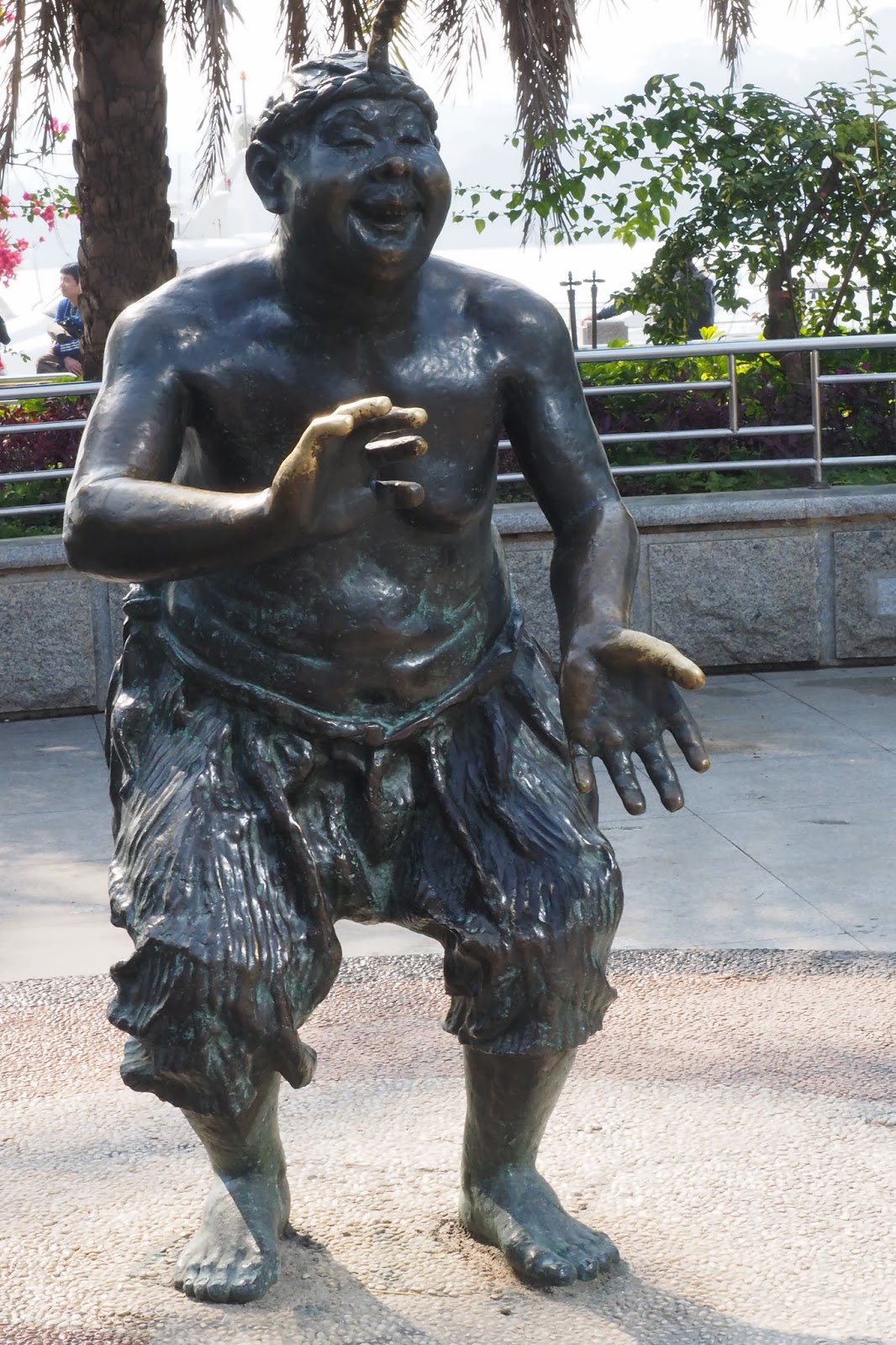One of my most surprising findings in this trip is how outwardly clean and pleasant the physical environment in Amoy is.
One could see the buildings across the straightened coastline
The surface of the enclosed sea/lake looks so spotlessly clean. I was told by our guide that no factories which may produce pollution would be permitted within the boundaries of the city.
The sun has come out
The sun in the water
There is a jetty for pleasure crafts for a water tour of the city
Reflections at the side of the jetty broken by a buoy.
There was a small bay in the middle of the walkway.
In the middle of the bay is a mermaid
She has a stork on her shoulder: the stork is the city bird of Amoy

This is the sidewalk to a huge park beside the hotel which would stretch for several kilometers and one could walk on both sides of the coastal broadwalk.

A closer view of the same bridge
This is the corner of one side of the broadwalk.

When I turned the corner, I found that it led to another branch of the same waterway .
the water is as clean and calm as the other branch
It would continue on and turn another corner.
A cat I found on at the side of the park, enjoying the morning sunlight .
There was some morning mist
I soon reached the arched bridge I saw earlier under which the reflections of the riverside building could be clearly seen.
Some Christmas flowers in the park
The "bear's paw"
"trumpet" flowers
Pink paper flowers
red paper flowers
roses
Orchids in purple
orchids in red
orchids in pink and red
More paper flowers found on my way back to the hotel by the other side of the park
All red under the morning sun
I have seen these flowers in white, orange or red or even purple but never two colors at the same time.
Two colors split right in the middle!
There is a square in the park where open air concerts may be held
Some sculpture at the square with two stylised dragons holding up what appears to be a smiling face of a man with the traditional stylised clouds one finds in traditional Chinese wood and jade carvings
This is a square to celebrate the return of sovereignty over Hong Kong to China in 1997.
When I went further back in the direction of our hotel, I found these modern sculptures of people embracing each other.

Young men rowing hard beside some bushes
it was a dragon boat with the captain right behind its head
As it was still early, I continued to walk along the river bank on the other side of the park and found another jetty for water tour boats
The landing pier
Another part of the riverside park
A little distance from our hotel
The water was calm
I like the reflections of the trees in the still water amidst those of the buildings
An old couple relaxing in the shades
a hideaway little pond
Though motor cycles are banned for causing traffic jams, certain government departments are granted exemptions.
A boulder announcing that I was entering the ground of an academy
there's a huge lawn in front of the academy
That's the front entrance of the academy specializing in the study of ancient Chinese classics
Two of its ancillary buildings
there's also an art gallery nearby but it was not yet open
another boulder advising us to relax
I found some statues of two bronze figures trying to sift something with a traditional wooden instrument
and a tray containing what appear to be tea leaves
It was a tea museum! Fujian is an important tea producing province.
There were trees everywhere.
And fallen petals
Time to head back to the hotel through this gate or I'll be late for the day's tour.
At the mouth of the harbour, there is a wetland park for birds
a leisurely duck
a red bill black swan. But most had left just a few days ago
They appear to get along fine with each other

like this couple at our hotel
or these bottles of whisky on the shelf of our hotel bar: each with a different taste.

or these towers of the chocolate castle in our buffet room, each taking up its own corner in space.
We were taken for a short tour of the city's "coffee house street"
They look quite European in style
This café even got a French name "Rencontrer" meaning "To Meet"!

This one is called Samadthi ( should it be Samadhi?), a term in the Buddhist yogic meditation tradition meaning the 8th and final stage of deep meditation or dhyāna as laid down in the Yoga Sūtras of Patañjali. I wonder what those going in would be thinking about? It certainly sounds phoney and false to me. What would scheming merchants not do just to earn an extra fast buck or two!
The cafe restaurants have all got European style decorations, complete with canopy, plants, flowers and parasols etc.
But for the more older and more traditionally-minded residents, a tea-house is still their preferred choice for relaxing with friends.
Opposite the rows of cafés, there are rows of car parks for those who can afford to come. We're told by our guide that one in three residents in Amoy has got his own car. Much better than even Hong Kong. But then we got an extremely efficient mass transit system.
A sign by the municipal authorities declaring that that it's their aim to build a civilized and safe Amoy. There's electronic surveillance on all important strategic locations. Our local guide tells us that the declared aim of the local police is that they would be on the scene within 3 minutes of any traffic accident and that if they fail to deal with any case satisfactorily, they would be fined and in a serious case dismissed. The Amoy police learns from Singapore: to stamp out corruption, they pay their junior rank and file police very well, So there's more incentive for them not to resort to corruption as in other Chinese cities.
An expensive sports car parked by the roadside on that street.
But sports cars are for brash young men and even the not so young. A grandmother will much prefer a leisurely morning stroll with with her grandsonl at the riverside park.
There's always flowers to soothe one's mind and one's heart....
and how they bloom!
We were then taken for a brief visit to the South Putuo Buddhist Temple or the Nanputuo (南普陀寺) right next to the Xiamen University, whose history went back to the T end of the Tang Dynasty and is named after the famous temple of the same name in Zhejiang province further north. It's dedicated to the Goddess of Mercy (Guanyin) (觀世音菩薩). When first built it was called The Four Province Temple (泗洲寺) and was rebuilt during the Northern Sung Dynasty and renamed Endless Rock (無盡岩), then fell into disuse during the Yuan Dynasty and then rebuilt again during the Ming Dynasty and renamed All Enlightening Temple (普照寺) and relocated here but it was again deserted during the Qing Dynasty until 1684 when it was renovated and expandded and rededicated to the Amitaba Bodhisattva n) ( and has since become one of the most popular temples during the Nationalist government. However, it suffered serious damage again during the Cultural Revolution in the late 1960s when part of it was turned into an electroplating factory and the rest into a primary school but when the Cultural Revolution ended in 1976, it was re-organized by a management committee led by an abbot (方丈), temple chief (堂主) and a temple supervisor (監院). It wasn't until 1989 that it resumed the traditional abbot system. The Temple belongs to the Linji School of Zen Buddhism (臨濟宗 ) and was home to the Min-Nan Buddhist College (閩南佛學院) since 1924 and in 1934, Master Wang Yi (弘一法師) and Master He Jin (和今法師) established the Nurturing Rectitude Buddhist Academy (佛教養正院). Its abbot since 2005 is Master Je Wu (則悟法師). The 30,00 square meter temple has 3 Halls and 7 Rooms (三殿七堂), its main south-north axis occupied successively by King of Heaven Hall (天王殿), Mahāvīra Hall (大雄寶殿), the Hall of Great Compassion (大悲殿) and the Buddhist Text Depository (藏經閣). To its left are found the dormitories, Bell Tower (鐘樓), Drum Tower (鼓樓), Good Karma Room (功德樓), Sea Encounter Room (海會樓), All Enlightening Room (普照樓), The Library of Ultimate Detachment (太虛圖書館) and the Lecture Rooms of the Buddhist College. There is a square in front of the King of Heaven Hall which opens on to a 30 meter square Life Liberation Pond (放生池) and a Lotus Pond(蓮花池).
The main entrance to the Temple
Some construction work was going on between the main temple and the side temple.

The other side of the Hall of Defenders of the Dharma

The entrance to the temple
The Hall of the Defenders of the Dharma
The tortoises in the "Liberation Pool"
A lady devoutly offering a joss stick. What is she praying for: health, wealth or love?

The inside of the main entrance

The inside view of the entrance Hall of the Defenders of the Dharma

The inside of the main entrance

The inside view of the entrance Hall of the Defenders of the Dharma
To the left, we find the room for the 4 Defenders of the Dharma (四大護法金剛/天王). This is Dhritarastra (持國天王), governing the East, holding the pipa (琵琶) which can produce a harmonious sound only if the strings are pluck neither too lightly or too hard signifying the need to follow the Madyamaka (Middle Way) (中觀).
Vidradhaka (增長天王), governing the south, holding sword to cut away all sources of suffering or dukka (苦)) arising from all kinds of worries caused by inappropriate and improper mental activitiies or skandas (煩惱) and to protect the Dharma.
The
Virapaksa (廣目天王), governing the West, his big eyes ever watchful,
holding a serpent in one hand signifying the treachery that the common
folks face in life and a jewel in the other signifying the need to hold
on to the jewel of the Dharma,
A number of bodhisattvas guarding the entrance to the Mahāvīra Hall
The entrance to the Mahāvīra Hall
Colorful flowers on the steps to the Mahāvīra Hall
garlands for the Buddha hanging on a branch nearby
The Mahāvīra Hall
The great Buddha

The right hand part of the couplet to the Hall of the Guanyin: "the purifying true view enabling us to see the great wisdom"
The left hand part of the couplet to the same hall: " the sound of waves in the sea of sound better than the idle sound from the other world".
The Sacred Text Depository
The first part of the couplet to the Sacred Text Depository: "getting the wonderful dharma to reach ultimate purity".
The second part to the couplet: "able to write, read, recite and receive blessing".
another line on a column: " helping all as if one were a rafter"
The eaves were decorated with good quality wood carvings: an elephant

Another elephant
a dragon?
a deer?
a dog?

A lion
Another lion
The god of fortune, the god of good official salary and the god of longevity
A scene of abundant harvest
Two birds playing with the lion
Another lion playing with a pheasant
A monk standing guard over the entrance to the main hall
The top of the corridor roof was decorated with finely crafted rafters
After the Hall for the Deposit of Sacred Texts, there's a path which leads uphill to the caves of the Hill of Five Elders (五老峰) above the temple, crowded with faithfuls and visitors.
One of the caves also had various effigies of Chinese gods like Lord Kwan (關公). What is he doing there? But to the ordinary folks, gods are gods, whether they are Buddhist or Taoists or just plain old folk deities. .
Half way up the hill, there is a temple for the Tin Hau, of the Goddess of the Sea (天后) probably because she is supposed to be protector of fishermen. Or is the Guan Yin or the two rolled into one?
Offerings for the goddess

An an all red gift to the goddess
and beautiful flowers for her too
On this boulder on the hill top are the words: "The Dharma shall be there always."
In front of it, is a stele

There's a poem by the head of the Chinese Buddhist Association Zhao Puchu (趙樸初) about how he felt after he actually returned to his homeland when previously he could do so in spirit only.
The top of the boulder is surrounded by flowers
But for the girls, the main purpose of going to the temple might well be just to take some beautiful pictures.
On the way down, found these tattered strings clinging on to the branches of a tree in the temple, a bit like the Chiu.
The Room of Good Dharma
A father tending to the needs of her child in the pram. He must love children. There's another one in the arms of his wife standing a little way off.
he didn't neglect his other child either.
the flowers too seem to be smiling after he's gone.

Monks and laymen's clothes hanging out to dry in the corridor in front of the dormitory: utterly indifferent to the curious gaze of the world
The temple is really popular. There's scarcely a moment I did not see people streaming in. Whether their purpose has got anything to do with the Buddhist religion, I wouldn't know.
Many of those who came appeared quite young. What does that tell us about whether Socialism satisfies their desire for finding meaning?
Though on temple grounds, this young lady seems totally unable to desert her social contacts.
These young monks seem in a big hurry. Perhaps they don't want to miss their lessons.

But for me, it's time for lunch
Reflections of "fortune" on the surface of the water of the pool outside the entrance hall to the dining room: the "fortune" has somehow melted or broken up there.
But not inside the dining room. There's plenty to eat. And they're very very tasty too. We were told that even the Chinese Premier praised the quality of the vegetarian meals there.
The so-called "vegetarian goose slices" . Ah.... yummy,
Flowers in the courtyard outside . A feast not just for the tummy.
After the meal, the city tour continues. This used to be the Amoy headquarters of Imperial Customs Service of the Qing government run by British officials.
Close to the harbour, I found these happy dancing natives.
See how happy this little fat fellow looks !
Could they be there to give the huge number of Taiwanese in Amoy a little comfort through something with which they feel a little sense of their home across the Taiwan Straits ?
Many previous buildings erected by Westerners are now occupied by either banks or hotels.
This modern building is occupied by Cheung Kong Group of companies.
But do these flowers care who owns what where when how or why?



































































































































沒有留言:
張貼留言